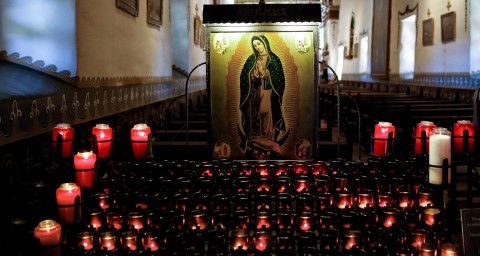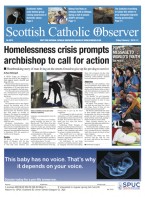November 30 | ![]() 0 COMMENTS
0 COMMENTS ![]() print
print

Mass can guide us from the pain of grief
In the month of Holy Souls, Fr Michael Conroy looks at the emotional homelessness that is bereavement
Bereavement has been likened to homelessness. Yes, the building called home is externally intact but internally there is a sense of emptiness.
There is emotional homelessness. A person or family is emotionally, physically and spiritually separated from a loved one who used to stay in the same house.
It is a raw, stark and shuddering comment.
The emotional experience of homelessness is connected to loss. In bereavement the loss is the grief for someone who was part of the structure and fabric of the house.
A loved one who inhabited the house, moving from room to room, is missing and now there is bereftness. As someone said, ‘There is no one to come home to.’
Again, every home has a routine, people have their timetables for leisure, work and domestic arrangements. Now there is a loss of rhythm and regularity.
There is also a loss of role. In a family we all have a role: mother, father, son, daughter, grandfather, grandmother.
There is connectivity to the extent that we can relate to others in terms of intimacy and communication.
Burden
I have heard people say before: “I’m finding it difficult to share myself with others, I don’t want to burden others with my feelings and thoughts.”
All in all, bereavement brings a sense of social isolation, inadequacy, aloneness and loss of attachment.
There are some Gospel passages which describe this sense of emotional homelessness.
In the Gospel of John, the death of Lazarus is narrated (John 11). In the words of the Gospel the effects of bereavement on the two sisters are described.
The words reflect emotional homelessness. We are told that Martha ‘went to meet him… Mary remained sitting in the house.’
It is as if both reflect oscillating and contrasting emotions in their loss, which are intensified by the coming of Jesus into a ‘family’ home which he had visited often.
Martha is actively running about trying to organise matters. Mary is passive, as if stuck and struck by shock.
Bereavement
Emotionally, it comes across that they are not coping on their own or together in an empty home on account of the death. Bereavement and grief are causing loss, rupture and shakiness in their home.
The raising of Lazarus by Jesus is a restoration of life and homefulness.
There is a sense of renewed attachment. The home is intact emotionally.
The family is at home, physically and spiritually. It is the sad journey from homelessness to the hope-filled journey of homefulness.
The same Gospel (John 19:25-27) describes the people at the foot of the Cross.
The emotional image and reality of the Cross as a sign of homelessness is not lost on any of us who have experienced death and loss.
In the Gospel, Jesus, at the point of death. says to Mary, His mother: “Woman, this is your son.”
Then to John the beloved disciple He says: “This is your mother.”
Empathy conjoined with Christian imagination would see this comment as heartbreaking.
The crucial phrase is next: “And from that hour the disciple took her into his home.”
Remembrance
Christian imagination and sensitivity do allow us to reflect that the ‘homelife’ of Mary had fallen apart. She was grieving and totally lost.
The words of Jesus appear to comprehend this devastation and he creates a scene of homefulness for both Mary and John.
In November, parishes have the Mass of Remembrance for their dead.
For all of us our parish church is like ‘a second home.’ It is here that we meet together for the Eucharist, vigil and Sunday Mass.
It is in the House of God that we meet, pray for and celebrate with others.
It is a ‘house’ that we visit with our loved ones from time to time.
The Sign of Peace at Mass is sign of being at home with others.
The receiving of Jesus at Holy Communion is the Sacrament of ‘entering under His roof.’
It can be like a time of homefulness, a coming together to meet, talk and be with God and others in good and in sad times.
The House of God is a not an empty tomb or resting place but a sign of the Resurrection, of life, where we shall all meet together in the Kingdom.
A November Mass is the sad journey from emotional homelessness to hope-filled Homefulness.










